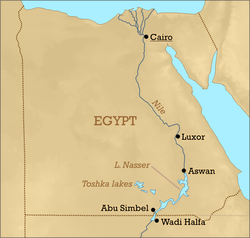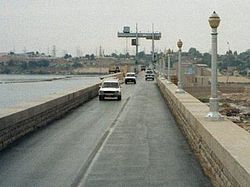Aswan Dam
From Wikipedia, the free encyclopedia

Aswan (Assuan) is a city on the first cataract of the Nile in Egypt. Two dams straddle the river at this point: the newer Aswan High Dam (Arabic: السد العالي; transliterated: as-Sad al-'Aly), and the older Aswan Dam or Aswan Low Dam. The aim of this water project was to prevent the river's flooding, generate electricity and provide water for agriculture.
Without impoundment the River Nile would flood each year during summer, as waters from East Africa flowed down the river as they did in ancient times. These floods brought nutrients and minerals that made the soil around the Nile fertile and ideal for farming. As the population along the river grew, there came a need to control the flood waters to protect and support farmland and cotton fields. In a high-water year, the whole crop may be entirely wiped out, while in a low-water year there was widespread drought and famine.
Contents |
[edit] Construction history
The British began construction of the first dam in 1889. Construction lasted until 1902. It was opened on December 10, 1902. The project was designed by Sir William Willcocks and involved several eminent engineers including Sir Benjamin Baker and Sir John Aird, whose firm, John Aird & Co., was the main contractor.[1] A gravity dam, it was 1,900 m long and 54 m high. The initial design was soon found to be inadequate and the height of the dam was raised in two phases, 1907–1912 and 1929–1933.
When the dam almost overflowed in 1946 it was decided that rather than raise the dam a third time, a second dam would be built 6 km upriver (about 4 miles). Proper planning began in 1952, just after the Egyptian Revolution led by the Free Officers, of whom Nasser was to become leader. At first the USA and Britain were to help finance construction with a loan of USD $270 million in return for Nasser's leadership on resolving the Arab-Israeli Conflict. However both nations cancelled the offer in July 1956 as part of the secret US-led 'OMEGA' policy to marginalize Nasser. A secret Egyptian arms agreement with Czechoslovakia (Eastern Bloc) and Egyptian recognition of the People's Republic of China are cited as possible reasons.
In 1958, the Soviet Union stepped in and funded the dam project. The Soviets also provided technicians and heavy machinery. The enormous rock and clay dam was designed by the Soviet Hydroproject Institute.
Construction began in 1960. The High Dam, as-Sad al-'Aali, an embankment dam, was completed on July 21, 1970, with the first stage finished in 1964. The reservoir began filling in 1964 while the dam was still under construction and first reached capacity in 1976. The reservoir raised concerns from archaeologists and a rescue operation was begun in 1960 under UNESCO. Sites were to be surveyed and excavated and 24 major monuments were moved to safer locations (see Abu Simbel) or granted to countries that helped with the works (such as the Debod temple in Madrid and the Temple of Dendur in New York).
On the Egyptian side, the project was led by Osman Ahmed Osman's Arab Contractors. The relatively young Osman underbid his only competitor by one-half [2]. Osman complained about the quality of the Soviet-supplied equipment and machinery, and successfully campaigned to have Soviet workers removed from the project. The project made the Arab Contractors, and Osman himself, national icons.
[edit] Specifications
The Aswan High Dam is 3,830 m in length, 980 m wide at the base, 40 m wide at the crest and 111 m tall. It contains 43 million m³ of material. At maximum, 11,000 m³ of water can pass through the dam every second. There are further emergency spillways for an extra 5000 m³ per second and the Toshka Canal links the reservoir to the Toshka Depression. The reservoir, named Lake Nasser, is 550 km long and 35 km at its widest with a surface area of 5,250 km² and holds 111 km³.
[edit] Benefits
The dam powers twelve generators each rated at 175 megawatts, producing a hydroelectric output of 2.1 gigawatts. Power generation began in 1967. When the dam first reached peak output it produced around half of Egypt's entire electricity production (about 15% by 1998) and allowed for the connection of most Egyptian villages to use electricity for the first time. The dam mitigated the effects of dangerous floods in 1964 and 1973 and of threatening droughts in 1972–73 and 1983–84. A new fishing industry has been created around Lake Nasser, though it is struggling due to its distance from any significant markets.
[edit] Environmental and cultural issues
| Please help improve this section by expanding it. Further information might be found on the talk page or at requests for expansion. |

Damming the Nile has caused a number of environmental and cultural issues. It flooded much of lower Nubia and over 90,000 people were displaced. Lake Nasser flooded valuable archaeological sites such as the fort at Buhen. The silt which was deposited in the yearly floods, and made the Nile floodplain fertile, is now held behind the dam. Silt deposited in the reservoir is lowering the water storage capacity of Lake Nasser. Poor irrigation practices are waterlogging soils and bringing salt to the surface. Mediterranean fishing declined after the dam was finished because nutrients that used to flow down the Nile to the Mediterranean were trapped behind the dam.[citation needed]
There is some erosion of farmland down-river as the river replenishes its sediment load. Erosion of coastline barriers due to lack of new sediments from floods will eventually cause loss of the brackish water lake fishery that is currently the largest source of fish for Egypt, and the subsidence of the Nile Delta will lead to inundation of the northern portion of the delta with seawater, in areas which are now used for rice crops.[citation needed] The delta itself, no longer renewed by Nile silt, has lost much of its fertility. The red-brick construction industry, which used delta mud, is also severely affected. There is significant erosion of coastlines (due to lack of sand, which was once brought by the Nile) all along the eastern Mediterranean.
The increased use of artificial fertilizers in farmland below the dam has caused chemical pollution which the traditional river silt did not. Indifferent irrigation control has also caused some farmland to be damaged by waterlogging and increased salinity, a problem complicated by the reduced flow of the river, which allows salt water to encroach further into the delta.

Mediterranean fish stocks are also negatively affected by the dam. The eastern basin of the Mediterranean is low in fertility, and traditionally the marine ecosystem depended on the rich flow of phosphate and silicates from the Nile outflow. Mediterranean catches decreased by almost half after the dam was constructed.[citation needed] The dam has been implicated in a rise in cases of schistosomiasis (bilharzia), due to the thick plant life that has grown up in Lake Nasser, which hosts the snails who carry the disease.
The Aswan Dam tends to increase the salinity of the Mediterranean Sea, and this affects the Mediterranean's outflow current into the Atlantic Ocean (see Strait of Gibraltar). This current can be traced thousands of kilometers into the Atlantic.
[edit] Irrigation for agriculture
Due to the absence of appreciable rainfall, Egypt's agriculture depends entirely on irrigation. With irrigation, two crops per year can be produced, except for sugar cane that has a growing period of almost one year. The high dam at Aswan releases on average 55 billion m³ water per year of which some 46 billion m³ are diverted into the irrigation canals. In Nile valley and delta, almost 8 million feddan (1 feddan is about 1 acre or 0.42 ha) benefit from these waters producing on average 1.8 crop per year. The annual crop consumptive use is about 38 billion m³. Hence, the overall irrigation efficiency is 38/46 = 0.82 or 82%.
Compared to the efficiency elsewhere in the world this is a high value. The field irrigation efficiencies are much less, but the losses are re-used downstream. This continuous re-use accounts for the high overall efficiency. The equal distribution of irrigation water over the branch canals taking off from the main irrigation canals leaves to be desired.[3]
| Branch canal | Water delivery in m³/feddan* |
|---|---|
| Kafret Nasser | 4700 |
| Beni Magdul | 3500 |
| El Mansuria | 3300 |
| El Hammami upstream | 2800 |
| El Hammami downstream | 1800 |
| El Shimi | 1200 |
* Period 1 March to 31 July. 1 feddan is about 1 acre or 0.42 ha. Data from Egyptian Water Use Management Project (EWUP)
The salt concentration of the water in the Aswan reservoir is about 0.25 kg/m³. This is very "sweet" water. At an annual inflow of 55 billion m³, the annual salt import reaches 14 million ton. The average salt concentration of the drainage water evacuated into the sea and the coastal lakes is 2.7 kg/m³ (Egyptian Drainage Research Institute, yearbook 1995/1996). At an annual discharge of 10 billion m³ (not counting the 2 billion m³ of salt intrusion from the sea and the lakes, see figure "Water balances"), the annual salt export reaches 27 million ton. In 1995, the salt export was higher than the import, and Egypt's agricultural lands were desalinizing. Part of this could be due to the large number of subsurface drainage projects executed in the last decades to control the water table and soil salinity.
[edit] External links
- Sayed El-Sayed and Gert L. van Dijken 'The southeastern Mediterranean ecosystem revisited: Thirty years after the construction of the Aswan High Dam.'
- Satellite views on Google Maps
- http://maps.google.com/maps?hl=en&ie=UTF8&z=14&ll=24.034001,32.865901&spn=0.056362,0.078535&t=k&om=1
- Info on the Aswan Dam









